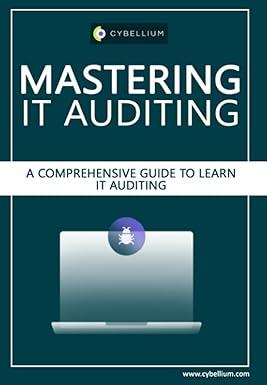Question
(send me the answer through a flash drive so i can save it on a flashdrive) Part 1 of 3 Lynbrook, Inc. applies the allowance
(send me the answer through a flash drive so i can save it on a flashdrive)
Part 1 of 3 Lynbrook, Inc. applies the allowance method to record transactions relating to their accounts receivables. On December 31, 2018, the company had a debit balance of $550,000 in Accounts Receivable and a credit balance of $15,000 in their Allowance for Doubtful Accounts. During 2019, the company completed a number of transactions involving sales on credit, accounts receivable collections, and bad debts. These transactions are summarized as follows: a. Provided $1,600,000 of delivery services on credit, terms n/30. b. Wrote off $20,000 of uncollectible accounts receivable. c. Received $1,200,000 cash in payment of accounts receivable. d. In adjusting the accounts on December 31, the company estimated that 1.5% of credit sales will eventually default. Required: Prepare journal entries (in proper general journal form) to record Lynbrooks summarized transactions above and its year-end adjustment to record bad debts expense. Part 2 of 3 As the recently appointed controller of Lynbrook, you would like to begin using the aging method to determine the ending balance in the Allowance for Doubtful Accounts. Your accounting staff provided you with the following aging schedule for Lynbrooks accounts receivable at December 31, 2019: Accounts Portion Expected Receivable Age Amount to Default Current 3,884,500 0.004 1-30 days past due 187,600 0.015 31-60 days past due 41,800 0.085 Over 60 days past due 21,400 0.200 Total 4,135,300 ` Before adjusting entries have been recorded, the balance in allowance for doubtful accounts is a debit of $4,600. (continued) Required: 1. Prepare the adjusting journal entry to record the bad debt expense. 2. Determine the Net Accounts Receivable (Net Realizable Value) amount that will be reported in the Balance Sheet on December 31, 2019. Part 3 of 3 Towards the end of 2019, Lynbrook, Inc. decided to begin accepting Notes Receivables from certain customers. Lynbrook had the following Notes Receivable transactions during 2019 and 2020. 2019 Dec.13 Accepted a $10,000, 45-day, 6% note dated December 13 in granting Tom Jones a time extension on his past-due account receivable. 31 Prepared an adjusting entry to record the accrued interest on the Jones note. 2020 Jan. 27 Received Jones' payment for principal and interest on the note dated December 13. Mar. 3 Accepted an $8,000, 9%, 90-day note dated March 3 from Andrea Greene in exchange for services provided on this date. June 1 Received the Greene payment for principal and interest on the note dated March 3. Required: Prepare the journal entries (in proper general journal form) for the above transactions, including the adjusting journal entry required on December 31, 2019. Note Lynbrook prepares adjusting journal entries annually on December 31. Reminder: Continue using the excel HW policies for preparing your solutions to the above questions, including the standard four line heading. All computations must be supported with proper excel formulas. (hint: record facts of the problem in a separate location in your spreadsheet and use their cell addresses in excel formulas when calculating amounts)
Step by Step Solution
There are 3 Steps involved in it
Step: 1

Get Instant Access to Expert-Tailored Solutions
See step-by-step solutions with expert insights and AI powered tools for academic success
Step: 2

Step: 3

Ace Your Homework with AI
Get the answers you need in no time with our AI-driven, step-by-step assistance
Get Started


